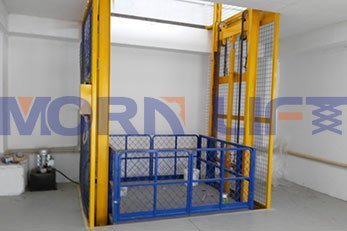Table of Contents
Usage Instructions
Before actually operate the cargo freight lift, run the hoist without a load through a few cycles.
Check and ensure that the hydraulic pressure line and joints have no leakages and that the electrical wiring is not damaged/exposed.
Ensure that the center of gravity should be in the central place of the work floor as far as possible.
Considerations
- Prohibit overloading.
- Hydraulic oil should be kept clean and must not be mixed with water and other impurities. The hydraulic oil should be replaced 2 months later for the first time, and then every six months (3 months longer than the first replacement). Once the hydraulic oil turns darker and tacky and contains grits or other foreign matters, it is time to replace the hydraulic oil. If a common temperature between 0 °C to 40 °C, please use No. 32# Hydraulic Oil; If common temperature over 40 °C, please use No. 46# Hydraulic Oil. If the common temperature is below 0 °C, please contact us for advice.
- When the platform fails to work, the power source should be promptly cut off.
Sick equipment operation is prohibited. A non-professional person shall not remove, adjust the hydraulic valve block and electrical components.
- When used on the ground, it should be guaranteed that there is enough space for platform fluctuation; inspect the power source line and the fuel tank pipeline to ensure there is no barrier around them and to avoid the line or the pipeline to break in the process of platform fluctuation.
Routine maintenance
Examine and maintain the lift weekly or once a month according to the lift operating frequencies
Check and ensure that the platform connection pin nuts are not loose
Check and ensure that the hydraulic tubing has no rupture, and all fittings have no leakages or are loosen
Check and ensure that the electrical lines are not damaged/exposed
Check and ensure that all joints at the main control panel are not loose and the indicating lights are functioning
Check and ensure that the limit switches are functioning
Check and ensure that the lubrication state of strut and cylinder pins is good
Ensure that the glide path is lubricated, there should be no friction between the rollers and the glide path
Check the safety railing is available. DO NOT take down the safety railings from the platform.
Check the safety rope and leveling rope, make sure they not loose.
Put grease to the wheel, chains, wire ropes, nylon blocks, every month
Regular Failure and Failure Elimination of Platform and Pump Station
| Failures | Reason | Elimination |
| Pump Station Fails (Platform cannot lift up) | 1 Power of electrical machine (25) is abnormal (virtual connection or inversion).
2 There is no oil or insufficient oil in the oil tank. 3 Oil filter(06) is dirty. 4 Normally closed valve(17) is dirty. 5 Normally closed valve(17) and motor(25) is on power-up state together. 6 Stated pressure of pressure regulating valve(21) is not sufficient 7 Gear pump(08) is damaged. 8 Hydraulic oil is contaminated. 9 Emergency decline valve’s bolt(19) is loose. 10The joint between the oil suction pipe(07) and gear pump(08) is loos causing air leakage. |
1 Connect the motor power correctly or regulate diversion.
2 Top-up hydraulic oil. 3 Clean the oil filter and change hydraulic oil. 4 Tear down the normally closed valve and wash it with a cleaning agent or paraffin. 5 Connect the lines correctly. When motor(25) electrify, the normally closed valve(17) should not be energized 6 Adjust pressure regulating valve(21). 7 Replace the gear pump(08). 8 Change hydraulic oil. 9 Tighten the emergency decline valve(19). 10 Tighten the oil suction pipe(07). |
| Pump Station Doesn’t Return Oil. (Platform
cannot be lowered) |
1 Normally closed valve(17) is not energized
2 The voltage and voltage type of normally closed valve coil(17b) is different from that of power. 3 The normally closed valve coil(17b) is damaged. 4 The normally closed valve nut(17c) is loose. 5 The flow speed control valve(23) is put off. 6 The normally closed valve(17) is jammed. |
1 Connect the lines correctly and check the voltage.
2 Check the voltage and its type(AC or DC). Supply the same voltage as the normally closed valve coil(17b). 3 Replace normally closed valve coil(17b). 4 Tighten the normally closed valve nut(17c). 5 Put on flow speed control valve(23). 6 Clean the normally closed valve(17) |
| Platform self decline | 1 Normally closed valve(17) or no-return valve(15) is dirty. 2 Emergency bolt(19) is loose.
3 Oil leakage from a hosepipe or hydraulic cylinder |
1 Clean or replace the normally closed valve(17) and no-return valve(15).
2 Tighten the emergency bolt(19). 3 Check hosepipe and oil cylinder. |
| Lift is swaying during operation | 1 Normally closed valve(17) is dirty.
2 Oil filter(06) is dirty or the oil suction pipe(07) is loose. 3 Hydraulic oil is contaminated or insufficient. 4 Power line is too long. 5 Emergency bolt(19) is loose. 6 The descending speed is too slow or too fast. 7 Air bubbles in the oil pipeline. 8 Cylinder’s piston rod is distorted or the seal kit is too tight. |
1 Clean the normally closed valve(17).
2 Replace oil filter(06) or tighten oil suction pipe(07). 3 Replace hydraulic oil or top up hydraulic oil. 4 Shorten power line. 5 Tight emergency bolt(19). 6 Adjust flow speed control valve(23). 7 Check and repair the oil pipeline. 8 Change hydraulic cylinder or seal kit. |



